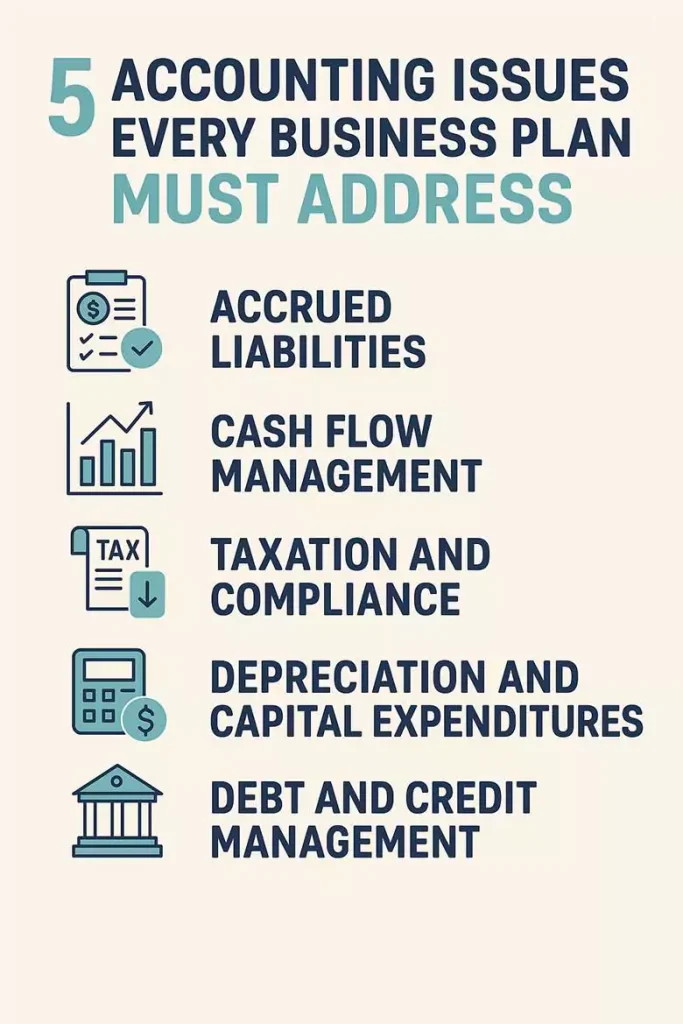Applying Accounting Issues and Problems to a Business Plan
Table of Contents
- Why Accounting Problems Belong in a Business Plan
- Linking Accounting to Strategy
- Accrued Liabilities: A Key Piece of the Puzzle
- Cash Flow Management
- The Role of Enterprise Lease Accounting Software
- Taxation and Compliance
- Depreciation and Capital Expenditures
- Debt and Credit Management
- Addressing Problems Honestly
- General Advice for Entrepreneurs
- Putting It All Together
- FAQs on Accounting Issues in Business Plans
Creating a business plan is often fun until you hit the serious stuff. Where you’re looking at costs and accounting rather than just sheer growth and money making Yet, at its core, a business plan must also face reality. And reality in business nearly always comes down to numbers. Accounting issues and problems, when acknowledged and addressed within a business plan, transform it from a wish list into a serious, credible, and executable document. Yet, there are certain way you need to implement it so that potential investors resonate with what you’re proposing.
While many entrepreneurs would rather focus on marketing slogans or product design, it’s the accounting layer of a business plan that investors, banks, and partners scrutinize most carefully. If your finances don’t make sense your ideas will quickly lose credibility.
This article explores how to apply accounting issues and problems to a business plan, with practical advice, examples, and insights. It will also highlight the role of accrued liabilities, one of the most misunderstood but important accounting elements for businesses.
Why Accounting Problems Belong in a Business Plan
Too often, business plans paint a rosy picture, presenting only the potential rewards of an idea. But seasoned investors know that every business will face hurdles, including accounting challenges. By weaving these issues into the business plan, you prove that you are not just ambitious but also pragmatic.
Accounting issues that deserve attention include cash flow timing, depreciation, taxation, credit management, and compliance with evolving standards. Acknowledging them upfront allows you to demonstrate foresight. For instance, a restaurant business plan that ignores seasonal fluctuations in revenue is incomplete, but if you address this in the right way it’ll demonstrate you’ve done your homework. Resolve complexities with skilled Business Plan Writers.
Linking Accounting to Strategy
Accounting is not just about recording transactions; it’s about informing decisions. When you apply accounting problems to a business plan, you can link financial data directly to strategy.
Imagine a SaaS startup: recurring revenue looks attractive, but without acknowledging delayed payments, rising subscription cancellations, or deferred expenses, projections can be misleading. A solid business plan would highlight these risks, propose measures like stricter credit policies or churn management, and show how accounting insights shape the broader growth strategy.
In this way, the business plan becomes more than just an optimistic projection—it becomes a roadmap that incorporates accounting as a feedback loop.
Accrued Liabilities: A Key Piece of the Puzzle
One area where business plans often stumble is in dealing with accrued liabilities. These are obligations a company has incurred but not yet paid. Think of wages earned by employees but not yet paid, utilities used but not yet billed, or interest that has accumulated on a loan but is not yet due.
Why do accrued liabilities matter in a business plan? Because they affect both the balance sheet and the cash flow statement, two of the most critical areas investors study. Ignoring them makes a business look healthier than it is. By properly accounting for these liabilities, you show the true financial position of your business. Founders can simplify accounting challenges by partnering with a Professional Business Plan Writer to build accurate forecasts.
For example, if your business expects $50,000 in revenue in a month but also owes $20,000 in accrued wages and utilities, your plan should reflect the net cash flow impact. Including this in your financial modeling helps avoid nasty surprises when bills come due. It also demonstrates that you understand the nuances of financial reporting, making your plan more credible.

Cash Flow Management
One of the biggest accounting issues that can sink a business plan is weak cash flow management. Many businesses that fail do so not because they were unprofitable on paper but because they ran out of cash.
Your business plan should highlight how you will manage inflows and outflows. Will you use invoice factoring to speed up collections? Will you negotiate payment terms with suppliers to ease short-term strain? By addressing potential cash flow problems, you add realism and demonstrate that your plan can survive the inevitable bumps.
The Role of Enterprise Lease Accounting Software
As businesses scale, tracking multiple leases—whether for equipment, vehicles, or office space—becomes increasingly complex. This is where enterprise lease accounting software proves invaluable. These platforms automate the process of recording leases, ensuring compliance with standards such as ASC 842 and IFRS 16. They also integrate with broader enterprise resource planning (ERP) systems, offering real-time reporting on lease liabilities, cash flow impacts, and renewal deadlines. For SaaS businesses in particular, enterprise lease accounting software reduces the risk of human error, saves time for finance teams, and provides executives with clearer insights into how lease obligations fit into overall strategy. By embedding this technology into their operations, companies can focus more on growth while staying compliant and financially transparent.
Taxation and Compliance
Taxes are another accounting issue often overlooked in business plans. Entrepreneurs may assume they can “figure it out later,” but investors know that tax mistakes can cripple a company.
A dynamic business plan doesn’t just project revenues—it considers the impact of corporate tax, payroll taxes, and even state-specific regulations. If your plan includes expansion, you should address how differing tax jurisdictions will be handled. This level of detail shows seriousness and foresight.
Depreciation and Capital Expenditures
If your business requires significant investment in equipment, vehicles, or property, your plan must include depreciation. Depreciation isn’t just an accounting entry—it impacts profit, taxes, and reinvestment needs.
For example, if your delivery startup relies on a fleet of vans, you must project how those assets lose value and when they’ll need replacement. A business plan that explicitly lays out depreciation schedules alongside reinvestment strategies will feel grounded and trustworthy.
Debt and Credit Management
Another common accounting issue is debt management. Will your business take out loans? How will you ensure repayment without starving operations?
A good business plan explains not just how much money you intend to borrow but also how repayment fits into cash flow. It should discuss interest rates, credit terms, and the strategy for avoiding over-leverage. Including this demonstrates that you’ve thought through both the opportunities and risks of financing.
Addressing Problems Honestly
The hallmark of a dynamic and credible business plan is honesty. Don’t gloss over accounting problems; highlight them and propose solutions.
For example, if your industry typically suffers from high customer churn, admit it in the plan and explain your accounting strategy for handling it. If your chosen revenue model requires significant upfront investment before profits arrive, address how you will bridge the financial gap.
By acknowledging problems, you earn trust. Investors and lenders know challenges are inevitable; what they want to see is your ability to anticipate and address them.
General Advice for Entrepreneurs
Entrepreneurs writing a business plan often struggle to integrate accounting issues without drowning in jargon. The key is clarity. Use plain language to explain problems and solutions. For instance, rather than saying “our EBITDA margin is compressed due to deferred amortization,” you might say “our operating profit looks lower in the early years because we’re spreading the cost of software licenses over time.”
This makes the accounting issues understandable to non-specialist readers while still showing that you grasp the mechanics.
Putting It All Together
A business plan that integrates accounting issues and problems is not just a financial document—it’s a narrative of foresight, resilience, and responsibility. Whether it’s acknowledging accrued liabilities, planning for depreciation, managing cash flow, or ensuring compliance, these elements transform a plan from hopeful to practical.
Investors, lenders, and partners don’t expect perfection; they expect preparedness. Show them that you understand both the upside and the accounting realities, and your business plan will stand out as grounded and actionable.
FAQs on Accounting Issues in Business Plans
- Why should accounting problems be included in a business plan?
Because they demonstrate foresight, realism, and credibility. A business plan that ignores accounting issues looks incomplete and unconvincing to investors. - What are accrued liabilities and why are they important?
Accrued liabilities are expenses that a business has incurred but not yet paid, such as wages or utilities. They matter because they show up as obligations on the balance sheet and impact true cash flow. - How can cash flow issues affect a business plan?
Even profitable businesses can fail if they run out of cash. A business plan must explain how cash will be managed—collections, payments, reserves—to show financial stability. - Should depreciation be included in a business plan?
Yes. If your business uses significant assets like equipment, vehicles, or property, depreciation impacts profits and taxes and should be included in your projections. - What’s the best way to discuss accounting issues without overwhelming readers?
Keep explanations simple and clear. Highlight the problem, explain why it matters, and outline the solution, avoiding excessive jargon. - Do investors really care about accounting details?
Absolutely. Investors and lenders often focus more on the accounting and financials than on the product itself. Clear, honest accounting builds trust. - How can small businesses in Alabama apply this advice?
By acknowledging common issues—like cash flow gaps, tax obligations, and accrued liabilities—in their business plans, even small businesses can present themselves as disciplined, credible, and ready for growth.

